Oviedo
I had always wanted to visit the heart of Asturias, and especially Oviedo, a city with a strong historical feel. Oviedo is the administrative centre of the Spanish province of Asturias, one of the so-called Celtic regions of the Iberian Peninsula. To its west and south west are Galicia and the north of Portugal. They too claim and sport the features of the ancient Celtic culture. This culture is still strong in the Atlantic regions of Europe, attracting travellers from far and wide.
Oviedo as a settlement dates back to the beginnings of the Kingdom of Asturias in the eighth century. Oviedo modelled much of its style on Toledo due to the wars between the Moors and the smaller Christian kingdoms. These kingdoms were continually springing up across the Iberian Peninsula from the eighth century onwards. This phenomenum helped gear up what was becoming the Reconquista, a period of about 800 years of war. Cities across the region preserve this history well and tourists flock to see and hear stories of swords and strife.
If you want to avoid the tourist crowds though, you could pick a low season. For example, we went at the end of the second week of the Easter holidays. There is still much to do and see, and you get to avoid queues and traffic jams in bars, restaurants and shops. That said, summertime in Asturias is nice, not just as stiflingly hot as other parts, and equally charming.
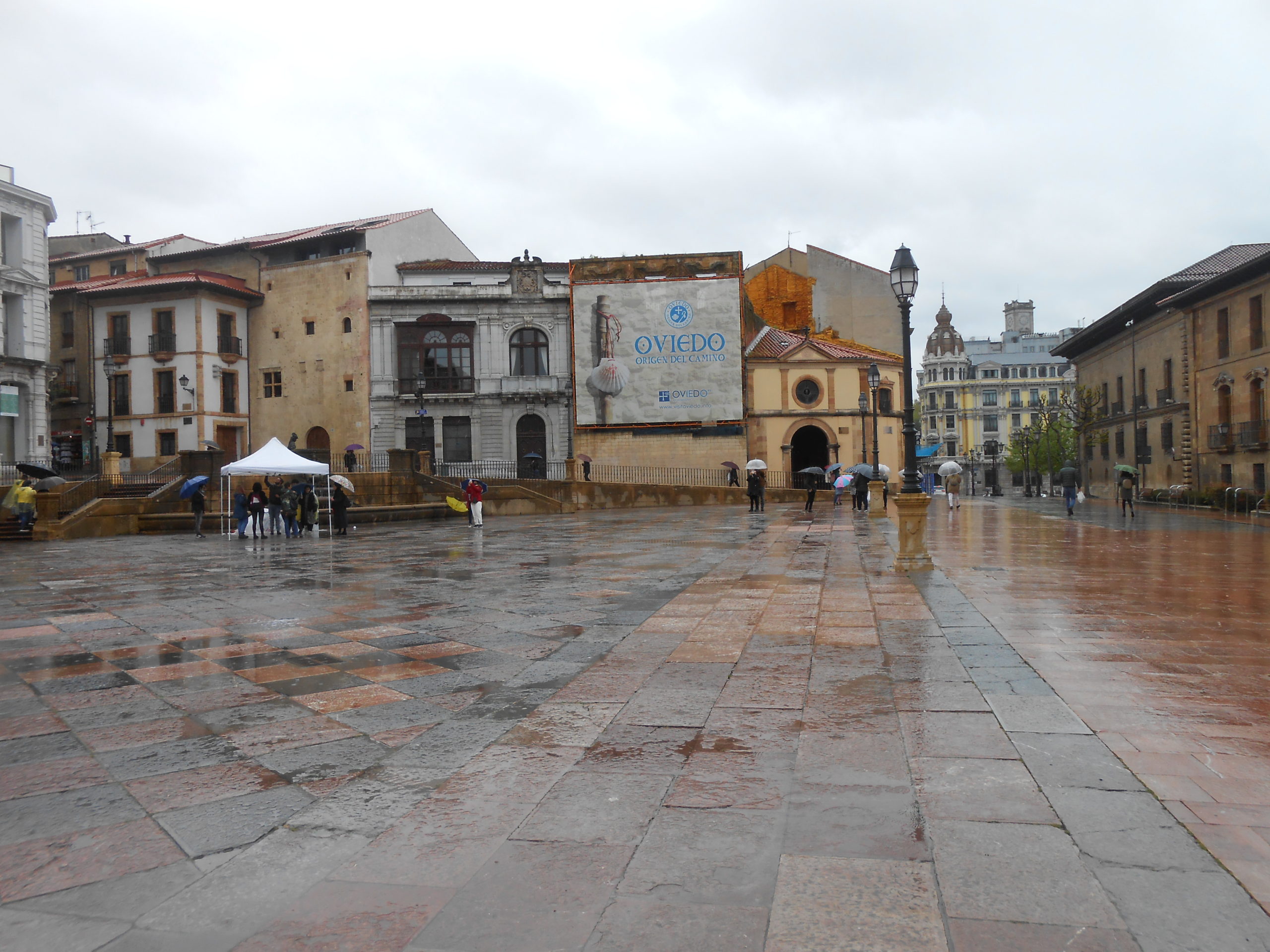
The Cathedral Plaza in Oviedo
Getting to Oviedo
For us, the bus gets us there in a wee bit less than four hours from our base camp in Bilbao. This is the furthest west I have been on the Iberian Peninsula, with the bus continuing on to Santiago de Compostella as it leaves us off at Oviedo bus station. There is a decent service from the coach company Alsa, which you can check out at this link, so overland arrival is possible. Alsa operates a lot of lines to and from a lot of places, so they are worth checking out.
If you are somewhere in the north and close to a train station, you can always take the slow train. It is scenic and you should try to do it at least once. However, you will need patience and you would also have to like taking the train, which I do. We did this previously to get to the eastern Asturian villages of Buelna and Pendueles, which you can read about here, and their neighbouring town of Llanes, which you can see here. If you are considering the train, the FEVE train service website is at this link.
If you fly into Oviedo, bear in mind that Asturias Airport is actually closer to the smaller coastal town of Áviles. It is about 21 miles, or 35 kilometres away from where you might think you are going. The airport has the abbreviation OVD, so is also sometimes known as Oviedo Airport. You can check the airport out here.
First Impressions of Oviedo
From within the city, you can see out toward the mountains of Asturias. The majority of the city itself sits between two and three hundred metres of elevation. Also being only about 19 miles, or 30 kilometres away from the sea, it has quite a pleasant maritime climate.
Which is probably why it starts raining on our first day. Well, the weather forecast had mentioned thunderstorms for that day, but these didn't materialise. The rain itself is light and there are plenty of bars with covered outdoor terraces. There are also lots of shops and covered areas in the city to hide in, so all is good.
Weather in Oviedo
The weather in Asturias is actually very nice, especially in summer, and especially if you are Irish, or of the north. Comparing it with the north means much less rain, much more sun and much the same level of green countryside as say, Ireland or Scotland.
It is therefore not really comparable with the south of Spain, which guarantees almost zero rain from certain months onwards. However, if you land in Oviedo in summer, you should pack the sunblock and sunglasses. A light rainjacket would be advisable but rain in summer isn't as common as you think.
Landscape around Oviedo
Speaking of green landscape, we're looking at a lot more white as we peer out towards the mountains. Snow crowns the Asturian mountains, a glorious sight indeed. However, the temperature in the city is almost at t-shirt levels, all in the third week of April.
Inside Oviedo city
The well-organised city is modern and practical, like the vast majority of major Spanish cities. The old part of town connects into a quite pedestrianised area of city with the scenic San Francisco park nearby. There are lots of plazas, churches and other buildings of historical interest, and statues dot the place.
History and Culture
As we have mentioned previously, Oviedo dates back to the foundations of the ancient Kingdom of Asturias. It is typically Spanish in that the history is very visible and accessible. Cities here preserve their history well and economically, it forms a significant part of their revenue. You can sit and have a coffee or beer anywhere around town, surrounded by visual memories of bygone times.
Culture and people
There is a right bit of pride in the ancient Celts here, and the tourist shops are full of t-shirts which you might associate more with Ireland or Scotland. The Celtic triskel, the pre-Christian trinity pattern, can be seen about the place and Celtic knotwork and spirals adorn shops and souvenirs alongside carvings and mini-statues of elves and pixies.
The people, for all their Celtic pride, seem typically Spanish, and like to show their local traditions to visitors.
The Camino Primitivo
This leg of the Camino de Santiago, or St. James' Walk, starts in Oviedo and many believe it is the original walk. The Camino Primitivo begins here and continues through Lugo, joining other routes close to Santiago de Compostella.
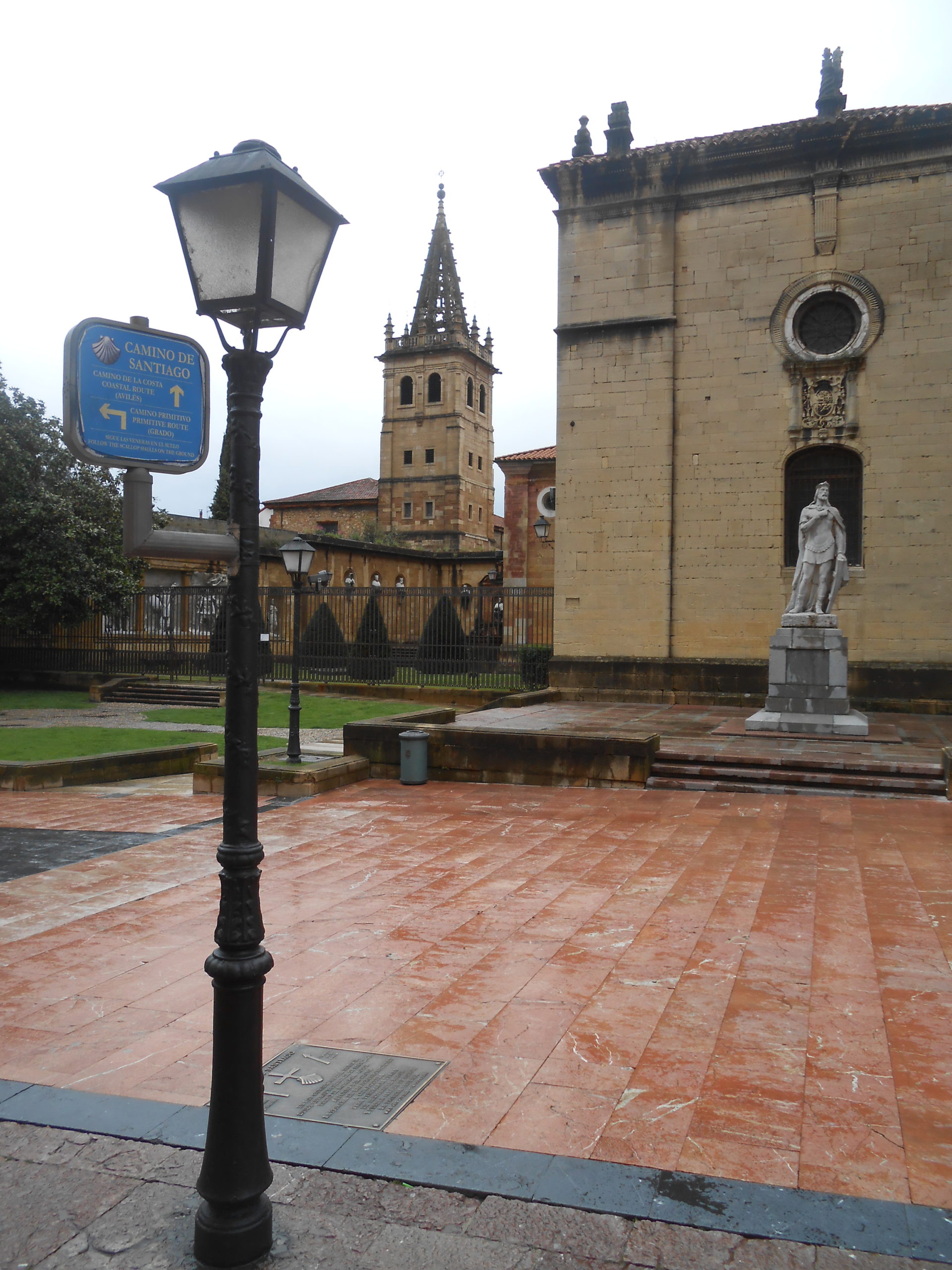
The road signs for the Camino Primitivo with the Asturian king Alfonso II, said to the first Christian pilgrim to walk the road to Santiago de Compostela
Our Own Experience
As travellers, we like to experience the places where the local people go. That often means us spending a lot of money in restaurants, thinking that we are doing the 'truly local' experience.
This time, we have opted for a stay in a reasonably-priced apartment so that we can cook ourselves. We also get it for cheaper as we have arrived at the tail end of the second week of Easter. We have therefore also managed to avoid any potential tourist crowds or traps.
There is a very reasonably-priced supermarket in a lot of Spanish cities called Mercadona, and it exists here in Oviedo. Luckily for us, our apartment is close to the historical quarter. Mercadona is a ten-minute walk and right bang in the middle of the old town.
Places to see and things to do in Oviedo
There are lots of things to see or do for various types of traveller in Oviedo. Visitors range from the passing pilgrim on the northern route of the Camino de Santiago to families, individuals and groups of travellers. Spain has a lot of internal tourism, so if you are of another land, you will rub shoulders with visitors from all over the country.
Here are a few places and ideas for visitors from wherever you are from:
1. The old town
Every city in Spain, more or less, has one of these, and they are normally the most stylish parts of town, in a rustic sort of way. For me, the more rustic, the better. They also tend to have the coolest bars and restaurants. However, the tourist office directed us through the old town towards a famous street full of ciderhouses. This is Calle Gascona, and is just outside of the old town.
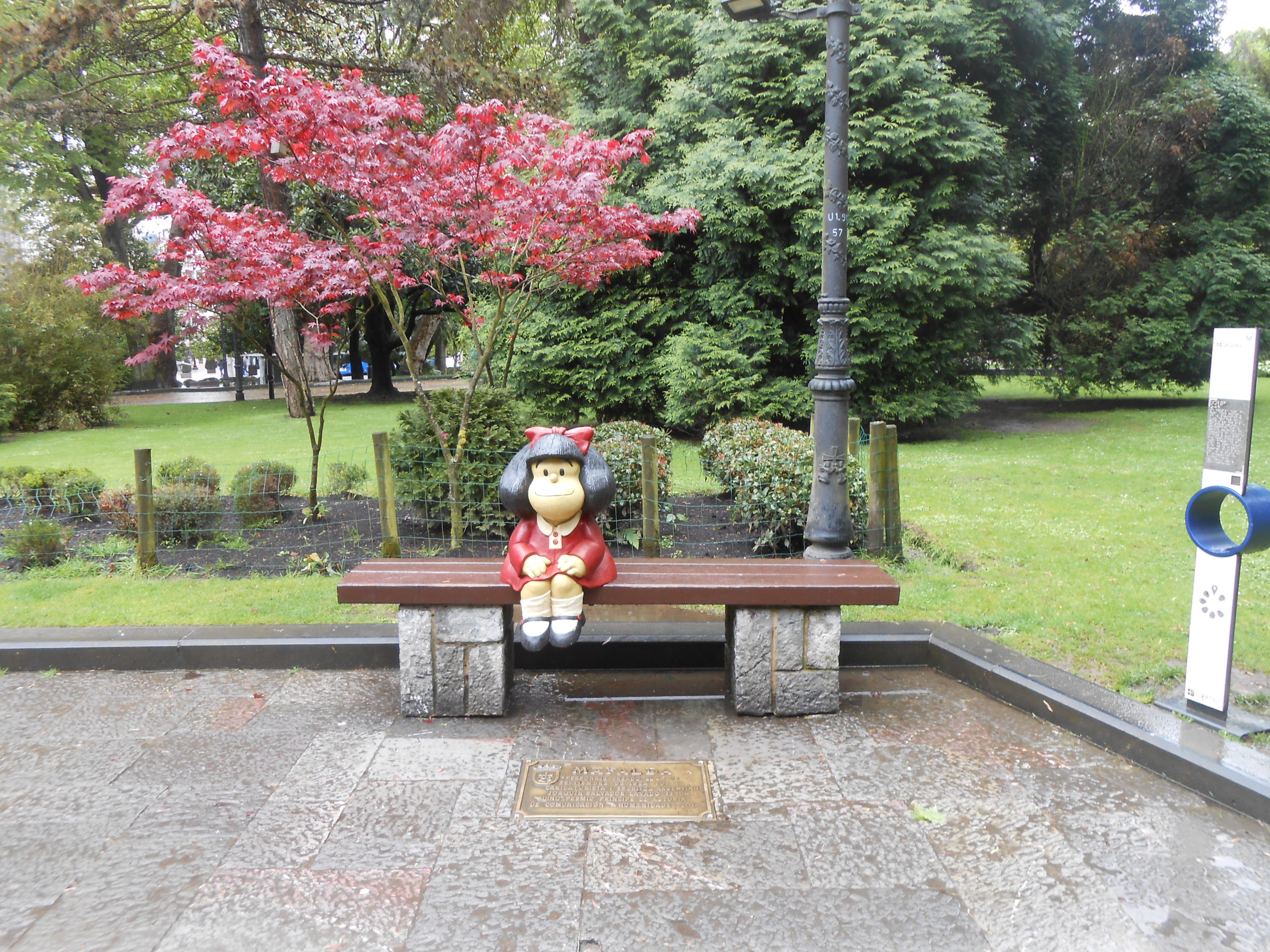
Mafalda, jovially overlooking the duck pond in Campo San Francisco in Oviedo
2. Campo San Francisco
A park absolutely full of statues in a city absolutely full of statues. this park is a nice place to get lost in for an hour or two. It's a nice place to take kids as there is plenty of space to run. There are also more than a few interesting statues that the kids can climb onto for photos.
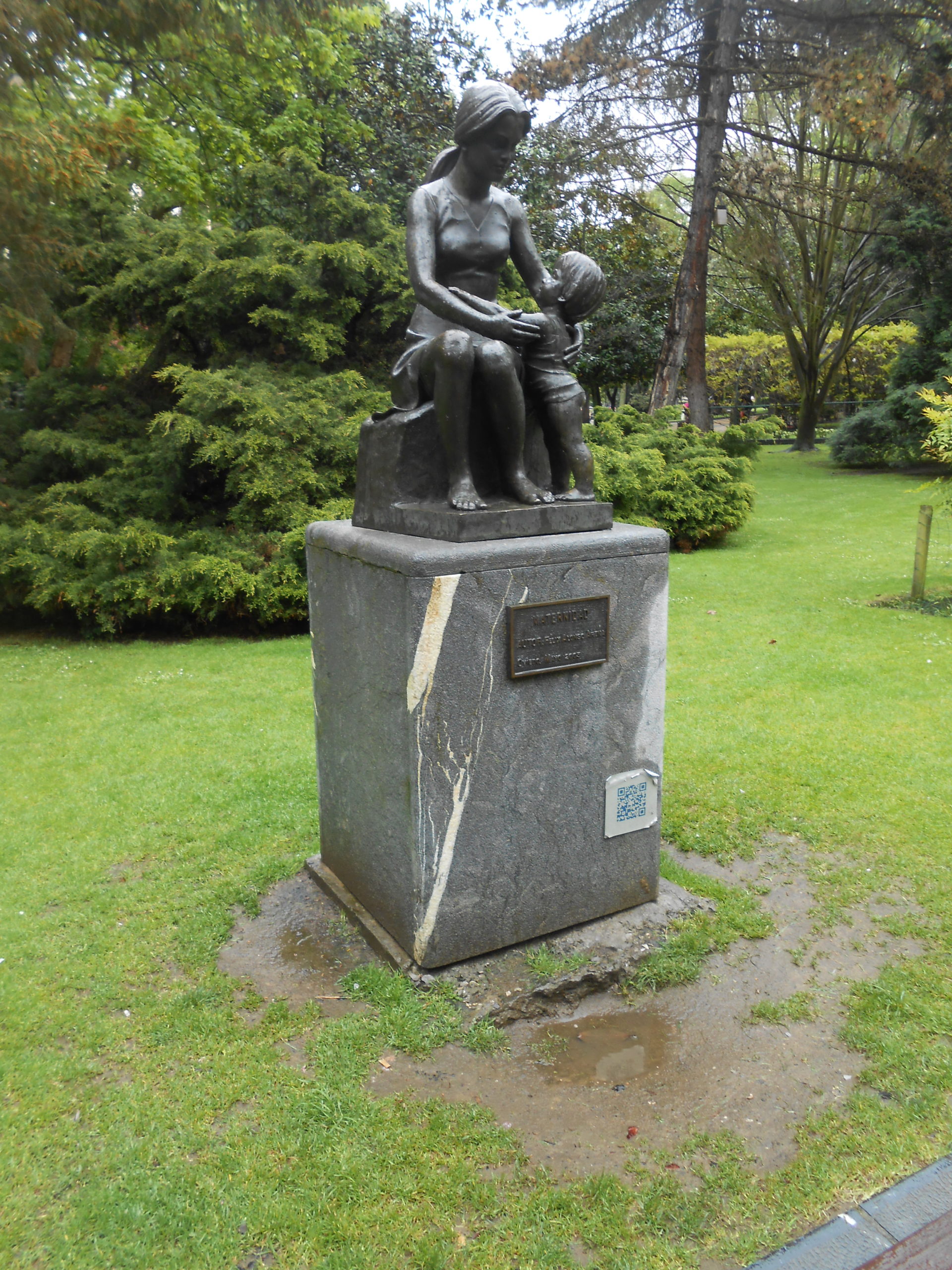
A statue honouring maternity in Campo San Francisco, Oviedo
3. Statue spotting in Oviedo
There are a lot of statues paying tribute to motherhood in Oviedo. Fernando Botero, the Colombian artist and sculptor, has one here and there are others depicting motherhood's travails.
This is definitely not the only theme shaped in metal, and other themes are on display. Mafalda, the famous satirical kid philosopher and creation of Argentine cartoonist Quino, sits looking across a duck pond in San Francisco Park.
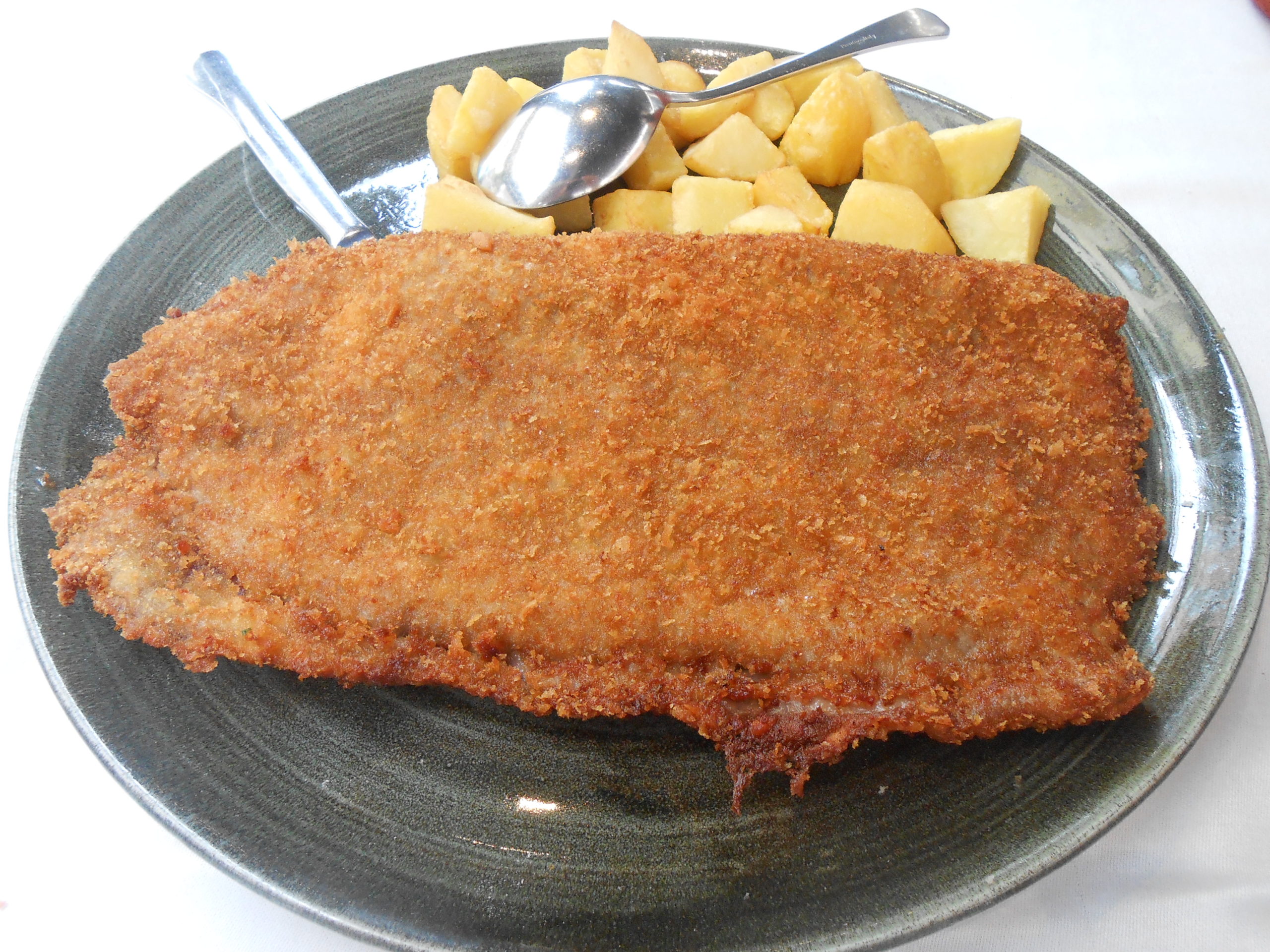
Cachopo, a typical Asturian dish. No, it's not battered fish but it's very nice!
4. Food and drink
The typical Asturian ciderhouse, or sidrería (pronounced /see-drair-EEH-ah/) serves copious amounts of the local world-famous cider with typical local dishes. One famous local delicacy is called cachopo (pronounced /kah-CHAW-paw/) and looks to the eye like a giant battered flatfish. It's actually breaded and fried ham and melted cheese with veal, and it's very nice. It is similar to a San Jacobo, which is a typical food around Spain, only the cachopo is done on a larger scale, normally feeding two or three diners.
The local cider often needs serving from distance and overarm, as if Rafa Nadal were serving you drinks. There are other locally-brewed drinks, such as orujo (/aw-ROO-haw/) and of course, beer is omnipresent.
5. Shopping in Oviedo
We found a lot of book shops! I'm not sure if Oviedo has more book shops than normal, but they are always a welcome addition to anywhere I visit. There are a lot of pedestrianised streets parallel to Calle Uría and on these, you can find different retailers. As well as these, there are plenty of coffee pitstops. Or beer of course.
You can read our related article on neighbouring Gijón at this link and you can see more of wider Asturias here.
So, Oviedo...yay or nay?
Most definitely a yay from us, due to its charm, selection of activities and proximity to other lovely places. These other areas may be the mountains and highlands, or the other nearby cities.
In any case, the ancient and noble land of Asturias is there to be enjoyed. If you seek alternatives to holidays on the Med but still crave the sun, you should get it here, on the Costa Verde, along with some amazing mountain and coastal views.
